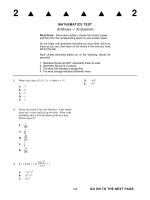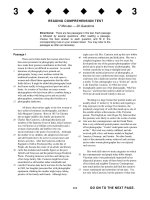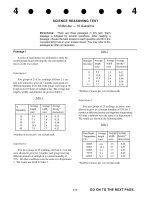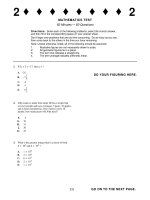READING COMPREHENSION TEST 17 Minutes — 20 Questions ppt
Bạn đang xem bản rút gọn của tài liệu. Xem và tải ngay bản đầy đủ của tài liệu tại đây (20.47 KB, 8 trang )
3 ◆ ◆ ◆ ◆ ◆ ◆ 3
202 GO ON TO THE NEXT PAGE.
READING COMPREHENSION TEST
17 Minutes — 20 Questions
Directions: There are two passages in this test. Each passage
is followed by several questions. After reading a passage,
choose the best answer to each question and fill in the
corresponding oval on your answer sheet. You may refer to the
passages as often as necessary.
Passage I
There can be little doubt that women artists have
been most prominent in photography and that they
have made their greatest contribution in this field. One
reason for this is not difficult to ascertain. As several
5 historians of photography have pointed out,
photography, being a new medium outside the
traditional academic framework, was wide open to
women and offered them opportunities that the older
fields did not. It might be added that photography lends
10 itself more readily to being practiced part-time and at
home. As a matter of fact there are many women
photographers who have been able to combine being a
wife and mother with being active and successful
photographers, sometimes using their kitchen as a
15 photographic darkroom.
All these observations apply to the first woman to
have achieved eminence in photography, and that is
Julia Margaret Cameron. Born in 1815 in Calcutta
into an upper-middle-class family and married to
20 Charles Hay Cameron, a distinguished jurist and
member of the Supreme Court of India, Julia Cameron
was well known as a brilliant conversationalist and a
woman of personality and intellect who was
unconventional to the point of eccentricity. Although
25 the mother of six children, she adopted several more
and still found time to be active in social causes and
literary activities. After the Camerons settled in
England in 1848 at Freshwater Bay on the Isle of
Wight, she became the center of an artistic and literary
30 circle that included such notable figures as the poet
Alfred Lord Tennyson and the painter George Frederick
Watts. Pursuing numerous activities and taking care
of her large family, Mrs. Cameron might have been
remembered as still another rather remarkable and
35 colorful Victorian lady had it not been for the fact that,
in 1863, her daughter presented her with photographic
equipment, thinking her mother might enjoy taking
pictures of her family and friends. Although forty-
eight years old, Mrs. Cameron took up this new hobby
40 with enormous enthusiasm and dedication. She was a
complete beginner, but within a very few years she
developed into one of the greatest photographers of her
period and a giant in the history of photography. She
worked ceaselessly as long as daylight lasted and
45 mastered the technical processes of photography, at
that time far more cumbersome than today, turning her
coal house into a darkroom and her chicken house into
a studio. To her, photography was a “divine art” and in
it she found her vocation. In 1864 she wrote
50 triumphantly under one of her photographs, “My First
Success,” and from then until her death in Ceylon in
1874 she devoted herself wholly to this art.
Working in a large format (her portrait studies are
usually about 11 inches by 14 inches) and requiring a
55 long exposure (on the average five minutes), she
produced a large body of work that stands up as one of
the notable artistic achievements of the Victorian
period. The English art critic Roger Fry believed that
her portraits were likely to outlive the works of artists
60 who were her contemporaries; and her friend Watts,
then a very celebrated portrait painter, inscribed on one
of her photographs, “I wish I could paint such a picture
as this.” Her work was widely exhibited, and she
received gold, silver, and bronze medals in England,
65 America, Germany, and Austria. No other female
artist of the nineteenth century achieved such acclaim
and no other woman photographer has ever enjoyed
such success.
Her work falls into two main categories on which
70 her contemporaries and people today differ sharply.
Victorian critics were particularly impressed by her
allegorical pictures, many of them based on the poems
of her friend and neighbor Tennyson. Contemporary
taste much prefers her portraits and finds her narrative
75 scenes sentimental and sometimes in bad taste. Yet,
not only Julia Cameron, but the painters of that time
3 ◆ ◆ ◆ ◆ ◆ ◆ 3
203 GO ON TO THE NEXT PAGE.
loved to depict subjects such as The Five Foolish
Virgins or Pray God, Bring Father Safely Home.
Still, today her fame rests upon her portraits for, as she
80 herself said, she was intent upon representing not only
the outer likeness but also the inner greatness of the
people she portrayed. Working with the utmost
dedication, she produced photographs of such eminent
Victorians as Tennyson, Browning, Carlyle, Trollope,
85 Longfellow, Watts, Darwin, Ellen Terry, Sir John
Herschel, who was a close friend of hers, and Mrs.
Duckworth, the mother of Virginia Woolf. These
photographs are among the greatest ever made and
should answer the question once and for all whether
90 photography is a fine art and whether women are
capable of artistic achievements equal to those of men.
1. Which of the following conclusions can be
reasonably drawn from the passage’s discussion of
Julia Margaret Cameron?
A. She was a traditional homemaker until she
discovered photography.
B. Her work holds a significant place in the
history of photography.
C. She was unable to achieve in her lifetime the
artistic recognition she deserved.
D. Her eccentricity has kept her from being taken
seriously by modern critics of photography.
2. According to the passage, Cameron is most respected
by modern critics for her:
F. portraits.
G. allegorical pictures.
H. use of a large format.
J. service in recording the faces of so many
twentieth century figures.
3. The author uses which of the following methods to
develop the second paragraph (lines 16-52)?
A. A series of anecdotes depicting Cameron’s
energy and unconventionality
B. A presentation of factual data demonstrating
Cameron’s importance in the history of
photography
C. A description of the author’s personal
acquaintance with Cameron
D. A chronological account of Cameron’s
background and artistic growth
4. Which of the following can reasonably be inferred
from the last sentence of the passage?
I. Some people have claimed that photography is
not a fine art.
II. Some people have claimed that women lack
the ability to produce great works of art.
III. No man has been able to equal Cameron’s
achievement in photography.
F. I only
G. II only
H. I and II only
J. I, II and III
5. When the author says that Cameron had found “her
vocation” (line 49), his main point is that
photography:
A. offered Cameron an escape from the confines
of conventional social life.
B. became the main interest of her life.
C. became her primary source of income.
D. provided her with a way to express her
religious beliefs.
3 ◆ ◆ ◆ ◆ ◆ ◆ 3
204 GO ON TO THE NEXT PAGE.
6. The main point of the third paragraph is that
Cameron:
F. achieved great artistic success during her
lifetime.
G. is the greatest photographer that ever lived.
H. was considered a more important artist during
her lifetime than she is now.
J. revolutionized photographic methods in the
Victorian era.
7. According to the passage, the art of photography
offered women artists more opportunities than did
other art forms because it:
A. did not require expensive materials.
B. allowed the artist to use family and friends for
subject matter.
C. was non-traditional.
D. required little artistic skill.
8. The Five Foolish Virgins and Pray God, Bring
Father Safely Home are examples of:
F. portraits of celebrated Victorians.
G. allegorical subjects of the sort that were
popular during the Victorian era.
H. photographs in which Cameron sought to
show a subject’s outer likeness and inner
greatness.
J. photographs by Cameron that were scoffed at
by her contemporaries.
9. According to the passage, which of the following
opinions of Cameron’s work was held by Victorian
critics but is NOT held by modern critics?
A. Photographs should be based on poems.
B. Her portraits are too sentimental.
C. Narrative scenes are often in bad taste.
D. Her allegorical pictures are her best work.
10. The author’s treatment of Cameron’s development as
a photographer can best be described as:
F. admiring.
G. condescending.
H. neutral.
J. defensive.
3 ◆ ◆ ◆ ◆ ◆ ◆ 3
205 GO ON TO THE NEXT PAGE.
THERE IS NO TEST MATERIAL ON THIS PAGE.
3 ◆ ◆ ◆ ◆ ◆ ◆ 3
206 GO ON TO THE NEXT PAGE.
Passage II
Perhaps nothing did more to intensify the strife
between North and South, and to emphasize in a most
dramatic way the determination of abolitionists to
destroy slavery, than the Underground Railroad.
5 Slaves who ran away were irritating and troublesome
enough, and the South had been plagued with them
from the earliest days of slavery. But when free blacks
and whites, fired with an almost fanatical zeal,
undertook systematically to wreak havoc on an
10 institution that meant so much to the South, it was
almost too much to bear. It was this organized effort
to undermine slavery, this manifestation of the
workings of a presumably higher law, that put such a
strain on intersectional relations and sent antagonists
15 and protagonists of slavery scurrying headlong intothe
1850s determined to have their uncompromising way.
The name Underground Railroad was probably
coined shortly after 1831 when steam railroads became
popular. There are several versions of how the
20 movement got its name. A plausible one concerns a
slave, Tice Davids, who escaped from his Kentucky
master in 1831 and got across the Ohio River.
Although the master was in hot pursuit, he lost all
trace of the slave after crossing the river, and was
25 so confounded that he declared the slave must have
“gone off on an underground road.” That was entirely
possible, for by 1831 there were plenty of
“underground” roads on the Ohio river, and they had
stations, conductors, and means of conveyance. From
30 that time, down to the outbreak of the Civil War, the
Underground Railroad operated in flagrant violation of
the federal fugitive slave laws. It was the most
eloquent defiance of the slaveholders that abolitionists
could make.
35 In the case of anything so full of adventure and
danger as the Underground Railroad, it is difficult to
separate fiction from fact. There are stories of
breathtaking escapes and exciting experiences that
would be quite incredible save for unquestionable
40 verification by reliable sources. After the Railroad had
developed an efficient organization, there was a
generality of practice that makes possible a brief
description of its operation. All, or almost all, of the
operations took place at night, for that was the only
45 time when the fugitive and his helpers felt even
partially secure. Slaves prepared to make their escape
by taking supplies from their masters and, if necessary,
by disguising themselves. Those of fair complexion
frequently passed as white persons and sometimes
50 posed as their own masters. Darker ones posed as
servants on their way to meet their owners. There are
several cases on record where fugitives were provided at
crucial moments with white babies in order to make
their claims of being nurses appear more convincing.
55 At times men posed as women and women as men.
Easily the most outstanding Negro conductor on
the Underground Railroad was Harriet Tubman.
Although frail of body and suffering from recurrent
spells of dizziness, she not only escaped from slavery
60 herself, but conveyed many others to freedom,
including her sister, her two children, and her aged
mother and father. She is said to have gone south
nineteen times and to have emancipated more than
three hundred slaves. Unable to read or write, she
65 nevertheless displayed remarkable ingenuity in the
management of her runaway caravans. She preferred to
start the journey on Saturday night, so that she could
be well on her way before the owners had an
opportunity the following Monday to advertise the
70 escape of their slaves. She tolerated no cowardice and
threatened to kill any slave who wished to turn back.
Well known in Philadelphia, New York, and Boston,
where she frequently delivered the escaped slaves, she
preferred to lead them all the way to Canada after the
75 passage of the Fugitive Slave Law in 1850, explaining
that she could not trust Uncle Sam with her people any
longer.
The very nature of the institution prevents any
accurate estimate of the number of slaves who found
80 freedom by the Underground Railroad. Governor
Quitman of Mississippi declared that between 1810 and
1850 the South lost 100,000 slaves valued at more
than $30 million. This is a much larger figure than
the census gives for Negroes in the North who were
85 born in slaveholding states, but Wilbur H. Siebert
believes that it is fairly accurate. He is certain, for
example, that approximately 40,000 passed through
Ohio alone.
The Underground Railroad intensified the
90 resentment that the South felt toward outside
interference. It was not realized that the Railroad ran
inside the South. Not only Northerners participated in
its management, but Southern whites and blacks were
among its most valuable engineers and conductors, and
95 all the passengers were Negroes desperately anxious to
get away from the peculiar institution of the South.
3 ◆ ◆ ◆ ◆ ◆ ◆ 3
207 GO ON TO THE NEXT PAGE.
11. The “eloquent defiance” mentioned in line 33 most
likely refers to:
A. the violation of the federal fugitive slave laws.
B. attacks made on slavery by abolitionists in
Congress.
C. the slaveholders’ arguments in support of
slavery.
D. the outbreak of Civil War.
12. The passage suggests that had it been known that the
Underground Railroad was supported by Southerners
as well as by Northerners:
F. friction between the South and North might
have lessened.
G. the South might have given up its fight to
preserve the institution of slavery.
H. Southern slaveowners might have succeeded in
stopping the Underground Railroad.
J. even more slaves might have had the courage
to attempt escape.
13. The main point of the first paragraph is that the
Underground Railroad:
A. systematically destroyed the slave-based
economy of the South.
B. demonstrated the North’s lack of understanding
of how important the institution of slavery
was to the South.
C. dramatically intensified the conflict between
the North and the South.
D. demonstrated the persistence with which slaves
tried to escape their situation.
14. According to the passage, many of the stories about
the Underground Railroad:
F. are only believable because they have been
confirmed by dependable sources.
G. were invented by abolitionists seeking to
undermine the institution of slavery.
H. were spread by slaveholders to intensify
conflict with the North.
J. were based on facts, but published as fictional
stories.
3 ◆ ◆ ◆ ◆ ◆ ◆ 3
208 GO ON TO THE NEXT PAGE.
15. According to the passage, which of the following
methods was NOT generally practiced on the
Underground Railroad?
A. Slaves would steal from their masters so as to
have provisions for their journey.
B. Slaves usually traveled during the day so as to
appear as normal as possible.
C. Slaves sometimes disguised themselves as
members of the opposite sex.
D. Slaves sometimes posed as their own masters.
16. It can be inferred from the passage that the number of
slaves who successfully escaped the South between
1810 and 1850 was:
F. not more than 40,000.
G. as high as 100,000.
H. less than the number of escaping slaves who
were caught.
J. consistent with Northern census figures.
17. In can be inferred from the details in the 4th
paragraph (lines 56-77) that:
A. slaveowners could be persuaded by Harriet
Tubman to emancipate their slaves.
B. in her efforts to help slaves escape, Harriet
Tubman usually disguised herself as a train
conductor.
C. slaveowners could do little to spread the news
of an escaped slave on a Sunday.
D. Harriet Tubman was often unnecessarily cruel
to the slaves she helped.
18. Harriet Tubman took escaping slaves all the way to
Canada because:
F. she felt that the law passed in 1850 meant that
escaped slaves were not safe even in the North.
G. she had become too well known in
Philadelphia, New York, and Boston.
H. escaped slaves’ chances for employment were
greater in Canada.
J. after 1850 the Underground Railroad
completely bypassed the northern cities she
was familiar with.
3 ◆ ◆ ◆ ◆ ◆ ◆ 3
STOP! END OF SECTION 3
DO NOT TURN TO ANY OTHER SECTION.
209
19. The passage suggests that the term Underground
Railroad may have come into use because:
A. the word “underground” implied illegality.
B. it referred to the fact that slaves disappeared as
if they had some way of traveling underground.
C. the growing system of steam railroads provided
an excellent means of travel for escaping
slaves.
D. antagonists of slavery dug a network of
tunnels to aid escaping slaves.
20. Which of the following are mentioned as tactics
employed by Harriet Tubman in her efforts to
emancipate slaves?
I. Sending letters to family members
II. Planning her rescue attempts on specific days
III. Threatening to kill slaves who had second
thoughts
F. I only
G. I and II only
H. II and III only
J. I, II and III









